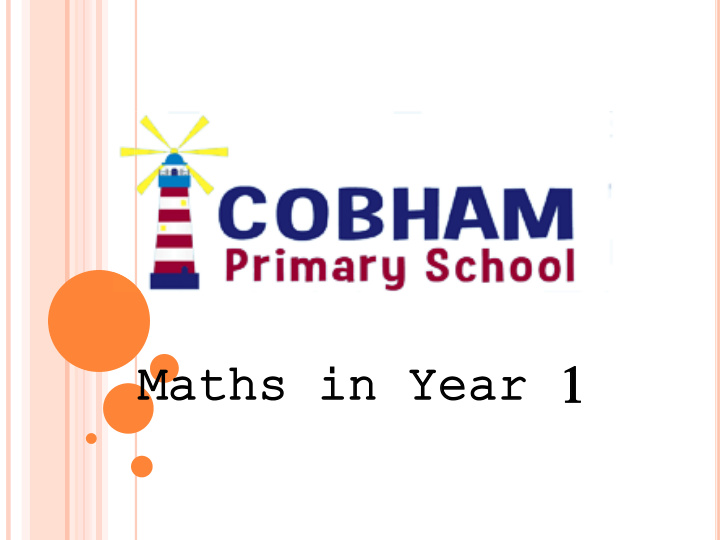



Maths in Year 1
Recap, Consolidation and Mastery
Maths across the school • Visual • Range of Manipulatives • Accurate use of Maths vocabulary • Ability to explain what they are doing and how they are solving a calculation • Widened curriculum • Using and applying • Whole school Maths investigations • Reasoning
E XAMPLE OF REASONING The children can talk about which one is the odd one out. There are no wrong answers as long as the children can justify their answers. We can then move onto numbers, shapes etc. at a later stage.
Recognition of Number and Formation • Number formation: we continue to practise this throughout the week. Please correct your child at home if they have incorrectly formed a number. Practise makes perfect! • Ask your children to tell you different numbers on a 100 square. Do they know numbers on a 100 square. Do they know their values?
Addition Progression Number Songs & Rhymes One More than Combining two groups Bar model Number line
C ALCULATION POLICY : ADDITION
A DDING USING A NUMBER LINE We use number lines to add and subtract. When we add, we jump ‘above’ the number line. Find the biggest number and then jump along the next number. E.g:
P ARTITIONING INTO TENS AND ONES Use lolly sticks 67= 60 + 7 Tens and ones grid:
I NTRODUCING A 100 SQUARE Understand how to add 10 (jump down) Knowing where to move to when we get to 10 (move down to next line) Work towards using 100 square to help add larger numbers
P ART P ART WHOLE FRAMES We have introduced part part whole frames this year. It enables children to see the relationships between addition and subtraction and works towards the bar model.
Bar Model: Reception Using cubes and objects to represent number Using cubes and objects to represent number Unknown Part Part • Count each part (record if ready to write the number sentence) • Be able to say - in the first part I have 5 and in the second part I have 3. • Understand that to find the total (unknown) they must count all the cubes or begin to count on from 5 to find the total. • Progress to reading a number sentence e.g. 5+3 = and be able to show the two part either with cubes or by recording on paper
Bar Model: Year 1 Using cubes and objects to represent number Using cubes and objects to represent number Unknown Part Part • We move on from using the bar model as a counting tool to understand that it is a visual representation. • The above bar model could represent any addition number sentence. • E.g. 26 + 13 = 39 • The children can visually see the answer must be greater than the two original numbers. • It works well when completing word problems. • Sally has 7 apples. Her mum gives her 12 more. How many does she have altoegther? • The unknown is shown with a dashed line. • The children then know they need to add the two smaller numbers to find a greater number.
O UR BAR MODEL JOURNEY Read the question and find out what to do. Write the number sentence. 12 + 7 = Draw the bar model. Use a number line to find the answer. Write the answer.
M ISSING NUMBERS We use our number lines to find missing numbers by counting on or back. We circle the numbers we know. Then we count the jumps. 13 + ... = 20
C ALCULATION POLICY : SUBTRACTION
Subtraction Progression Understanding one/two less than Subtracting from a group of objects Number Line Bar Model
S UBTRACTION USING A NUMBER LINE We always jump under for taking away. We talk about the answer will be smaller. We are beginning to use part part whole frames and the bar model for subtraction too.
S UBTRACTION USING THE BAR MODEL As with addition, we use the bar model as a visual representation, not a counting tool. 17 9 We talk about the unknown with addition and subtraction.
M ULTIPLICATION AND DIVISION We look at multiplication as repeated addition in Year 1. Repeated addition Arrays Sharing 8 Recording using the bar model 2 2 2 2 8 4 4
2d and 3d Shapes • Children to understand the difference between a 2d and 3d shape. • To be able to describe what the shape looks like and use some mathematical language to describe the shape E.g. Straight side, curved side and corner for 2d shapes Edge, face, vertices for 3d shapes • Recognise shapes in the environment and be able to describe them • Compare properties of different shapes
W HAT CAN YOU DO AT HOME ? Lots of practical Begin to use counting using a time...allow them range of objects to tell you the time, and ask Talk about them to tell you numbers in when it is a everyday certain time situations Most of Allow children to all...make maths handle money, fun! adding small amounts
Thank you Any questions?
Recommend
More recommend